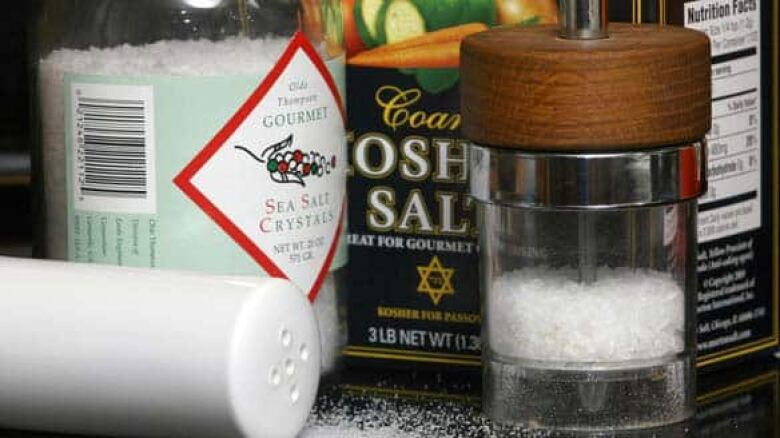How much sodium do I need?

Canadians are consuming far more sodium than they need to and it could be putting a strain on their health, according to Statistics Canada.
Recommended adequate sodium intake

- 1,000 mg for children age one to three.
- 1,200 mg for children age four to eight.
- 1,500 mg for people age nine to 50.
- 1,300 mg for adults age 51 to 70.
- 1,200 mg for seniors over 70.
Consuming more than2,300 mg of sodium per day increases your risk of health problems.
Canadians consume on average 3,400 mg of sodium every day, mostly through processed foods.
The agency issued a report on sodium intake in April 2007, which found that most people in all age groups were overdoing it when it came to salt.
Shortly after that, then health minister Tony Clement announced the formation of the Working Group on Sodium Reduction. It is made up of representatives of the food manufacturing and food service industries, health-focused non-governmental organizations, the scientific community, consumer advocacy groups, medical professional organizations and government.
On Sept. 14, 2009, the Canadian Medical Association Journal called for urgent action on developing a sodium reduction plan for Canada. The authors one of whom is a member of the working group note that people in Finland have reduced their sodium intake by 40 per cent since the 1970s, and mortality from stroke and coronary artery disease has fallen by 70 per cent in that time.
Finland's sodium-reduction strategy is based on regulation, partnership between government and the food industry and consumer education via mass media. The report says Canada should consider implementing a similar plan.
On Nov. 6, 2009, the Canadian Medical Association Journal reported that the Sodium Working Groupwould recommend the food industry make voluntary reductions as a first step.The food industry "is too diverse" to expect it to comply with mandatory regulations," Vice Chair Mary L'Abb told the Journal. Federal regulations would be too cumbersome, complex and expensive to implement.
L'Abb added that thetargets may bevoluntary, but theywould be very visible and public targets. They're expected to be modelled on the systemin place in the United Kingdom, whichuses red, amber and green warnings on food packages to alert consumers to salt levels.When the sodium content exceeds recommended levels, the product gets a red light.
Salty to a Fault
On Sept. 24, 2009, the Centre for Science in the Public Interest released a report, titled Salty to a Fault, that says excess sodium "likely kills more Canadians every year than any other chemical substance."
The report calls for immediate action to reduce the sodium intake of Canadians. Among its suggestions for Health Canada:
- Set sodium -reduction targets for key food categories.
- Require high-sodium warning labels where necessary.
- Monitor sodium levels in foods and conduct regular surveys of dietary sodium intake.
You can read the full report here.
Ata meeting in late September 2009, the Sodium Working Group agreed to set a goal of reducing sodium in the Canadian diet to 2,300 mg per day by 2016. That represents a five per cent reduction per year, based on the current average sodium intake of about 3,400 mg per day.
When the group released its sodium reduction strategy on July 29, 2010, it said thousands of lives would be saved if Canadians cut their sodium intake by half.
The report contained six overarching and 27 specific recommendations for government and industry, including:
- Support further research.
- Educate and raise awarenessabout saltcontent among consumers, industry, health professionals and other key stakeholders.
- Introduce structured, voluntary reductions of sodium levels in processed foods and foods sold in food service.
- Develop a plan to monitor and evaluate implementation of the recommendations.
The report also calls forimproved food labelling that enables consumersto better understand how much sodium a product contains; prominentdisplay of sodium and calorie information at chain restaurants and food service establishments; and reductions inchildren's exposureto marketing of foods that are high in sodium.
The report alsosaid "alternate measures" should be considered if sufficient progress on reducing sodium has not been achieved.

Groups representing the food andbeverage industry as well as the Heart and Stroke Foundation of Canada came out strongly in favour of the report's recommendations.
"The three-pronged strategy and subsequent recommendations put us on the right path for reducing heart disease and stroke,"Sally Brown, CEO ofthe Heart and Stroke Foundation said in a news release. "We urge the minister of health to respond to the report by the end of the year so that the implementation process may begin."
Canadian sodium levels among the highest
Sodium levels in selected products per 100 g serving
Kellogg's Bran Flakes
- Canada: 861 mg
- United States: 258 mg
Burger King onion rings
- Canada: 681 mg
- UK: 159 mg
KFC popcorn chicken
- Canada: 908 mg
- Malaysia: 560 mg
Source: World Action on Salt and Health
In July 2009, a report released by World Action on Salt a British-based group established in 2005 to help gradually reduce global salt intake found that sodium levels in a selection of processed and fast foods tended to be higher in Canada than in other countries.
The report found that for every 100 grams of Kellogg's All Bran sold in Canada, there was 861 mg of sodium the highest level of any country surveyed. In the United States, 100 grams of All Bran contained 258 mg of sodium.
"Sodium reduction in our cereals is an ongoing program for Kellogg Canada," Kellogg Canada vice-president Christine Lowry said at the time.
"As part of this project, we've already reduced sodium levels in our children's products and we are now focused on reducing sodium levels in our adult brands. We're hopeful that our current efforts behind All-Bran will achieve early success and will be in market soon."
A year later, sodium levels in All Bran remained the same.
Sodium and you
Your body needs some sodium to function properly. It is the primary electrolyte that regulates fluid levels in the body. Sodium keeps your body hydrated by pumping water into the cell. In turn, potassium flushes the byproducts of cellular processes out of the cell, eventually eliminating these "wastes" from the body. Your kidneys help regulate the amount of sodium in your body. When levels are low, the kidneys conserve the mineral. When levels are high, the kidneys excrete salt in your urine.
Sodium levels of selected cheeses (100 g portion)
- Feta1,744.6 mg.
- Mozzarella 751.9 mg.
- Processed slice (regular) 1662.5.
- Processed slice (light and fat-free) 1490.9.
- Cheddar (medium) 706.7
Source: Health Canada
If your kidneys can't get rid of enough sodium, it begins to accumulate in your blood. And that can cause problems because sodium attracts and holds water. More sodium increases blood volume, which in turn makes your heart work harder to move the blood through your body.
High sodium intake can push up your blood pressure and increase your risk of heart disease and stroke.
The Heart and Stroke Foundation suggests Canadian adults consume no more than five millilitres of salt (2,300 milligrams of sodium or a teaspoon of salt) per day. However, most adults consume far more than the recommended amount of sodium - a little more than 3,000 milligrams on average.
Your body needs only 500 mg of sodium per day to function under normal circumstances. Endurance athletes need more and should consume fluids that contain sodium if they are exercising for two hours or more.
I don't add salt to my food. Why should I be concerned?
Well, you don't have to be unless you have a penchant for foods like pizza, sandwiches, hamburgers or hot dogs. Or have the odd hankering for potato chips or pretzels. Or eat soup, pasta or poultry. Like to add a bit of soy sauce to your meals? Maybe eat a bit of cheese, cereal or beef?
They all contain varying levels of sodium and account for more than half of the sodium Canadians consume, according to that Statistics Canada report.
More than three-quarters of the sodium people consume comes from processed foods. The StatsCan researchers did not even look at the salt that people added to their food when they compiled their numbers.
"Yet it was the people who were already consuming the highest amounts of sodium in the foods they ate who reported most frequently adding salt," the report said.
What are the main sources of sodium?
There are three: processed and prepared foods, condiments that contain sodium, and natural sources of sodium.
Sodium is used in processed and prepared foods as a preservative and as a flavour enhancer. Some condiments contain a lot of sodium. Add 15 ml (one tablespoon) of soy sauce to your meal, and you've added 1,005 mg of sodium.
Sodium also occurs naturally in some foods such as meat, dairy products and vegetables. A slice of ham contains about 350 mg of sodium. Stick two pieces of whole wheat bread around it and you've added another 296 mg of sodium.
How do I know how much salt a product has?
Read the label. The Nutrition Facts table and the ingredient list will tell you how much sodium is in a serving of just about any food you buy:
- In Canada, products labelled sodium-free have less than five milligrams of sodium per serving.
- Reduced sodium products have at least 25 per cent less sodium per serving than the original product.
- Or look at the per cent daily values (% DV) and choose products that are 10 per cent or less for sodium.
Not all sodium content is listed as "sodium." You're also getting sodium from ingredients such as monosodium glutamate (MSG), baking soda, sodium sulfite, sodium nitrate or soy sauce.
How do I limit my sodium intake?
Besides pushing away the salt shaker, you can take steps such as:
- Eating more fresh fruits and vegetables.
- Choosing fresh, frozen or canned food items without added salts.
- Sticking to unsalted nuts and avoiding salty snacks like chips and pretzels.
- Opting for fat-free or low-fat milk, low-sodium, low-fat cheeses and low-fat yogurt.
- Selecting unsalted, fat-free broths, bouillons or soups.
- Seasoning your foods with herbs and spices instead of salt.












_(720p).jpg)


 OFFICIAL HD MUSIC VIDEO.jpg)
.jpg)



























































































